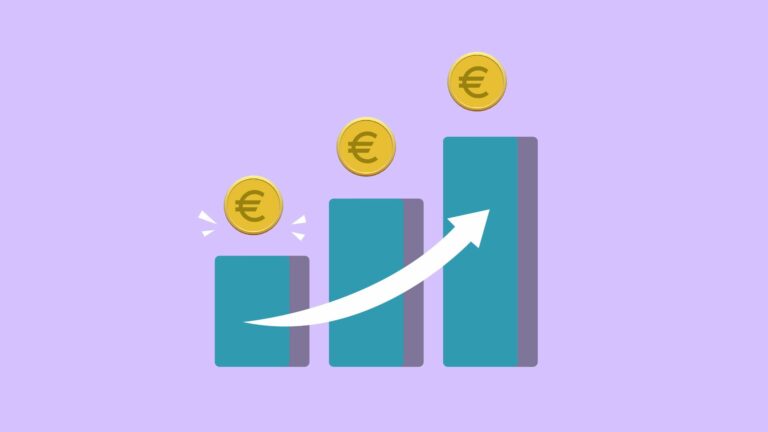The second triangle: the Descending Triangle
Read MoreActive vs Passive Investment In The Stock Market: Which Strategy Is Right for You?
Are you looking to invest in the stock market, but not sure which approach to take?

As the saying says, “Money makes the world go round.” And for those looking to grow their wealth, investing in the stock market has long been a popular option. When it comes to investing in the stock market, there are two primary strategies: active and passive. Active investing is a more hands-on approach, where investors try to beat the market by regularly buying and selling stocks based on market trends and analysis. Investing passively, however, takes a more relaxed approach, where investors buy and hold stocks in a diversified portfolio to match the overall market performance. Both strategies have their pros and cons, and choosing the right one for you depends on your investment goals, risk tolerance, and personal preferences. In this article, we’ll explore the differences between active and passive investing and help you decide which strategy is the right fit for your investment portfolio.
Table of Contents
Active vs Passive Investing

Before we dive into the specifics of each strategy, let’s take a closer look at the key differences between active and passive investing. Active investing involves a hands-on approach where investors make frequent trades in an attempt to outperform the market. This can involve extensive research and analysis of individual stocks, as well as keeping a close eye on market trends and economic indicators. Passive investing, on the other hand, is a more laid-back approach where investors buy and hold a diversified portfolio of stocks with the goal of matching the performance of the overall market.
One of the main differences between the two strategies is the level of involvement required. Active investing requires a significant amount of time and effort to research and analyze individual stocks, as well as stay on top of market trends and economic indicators. Passive investing, on the other hand, involves less time and effort, as investors simply need to choose a diversified portfolio of stocks and hold onto them for the long-term.
Another key difference between the two strategies is the potential for higher returns. Active investing has the potential to generate higher returns than passive investing, as investors actively seek out opportunities to outperform the market. However, this also comes with a higher level of risk, as investors may make mistakes or misjudgments that result in significant losses. In contrast, passive investing has a more predictable, consistent, and consistent return because investors monitor how the overall market performs, as opposed to investing in individual stocks and bonds.
Active Investing: Advantages and Disadvantages

If you’re looking for higher returns than the market, active investing can be a great option. Here are some of the key advantages and disadvantages of active investing:
One of the main advantages of active investing is the potential for higher returns than the overall market. By actively seeking out opportunities to outperform the market, investors can potentially generate significant returns over the long term. Next is flexibility. By investing actively, it opens up a great deal of flexibility, as they can adjust their portfolio as needed to take advantage of changing market conditions. This can be particularly advantageous during periods of market volatility, as active investors can quickly adjust their holdings to minimize losses or take advantage of buying opportunities.
On the other hand, one of the main well-known disadvantages of active investing is that it comes with a higher risk level than passive investing, as investors actively seek out opportunities to outperform the market. This can result in significant losses if investors make mistakes or misjudgements. Plus, active investing also tends to come with higher fees than passive investing, as investors may need to pay for research and analysis tools, as aforementioned as trading fees. These fees can reduce returns over the long term. Last but not least, active investing requires a significant amount of time and effort to research and analyze individual stocks. In addition, it requires staying on top of market trends and economic indicators. This can be a significant commitment for investors who are not willing or able to dedicate the necessary time and resources.
Active Investing Strategies: day trading, swing trading, value investing, growth investing
There are several different active investment strategies that investors can use to try to outperform the market. Here are a few of the most common:
1. Day Trading
Day trading involves buying and selling stocks within a single trading day. It’s about capitalizing on short-term price movements. Day traders typically use technical analysis to identify potential trading opportunities.
For example, a day trader might buy shares in a tech company like Apple (AAPL) at market open when they anticipate an upcoming product launch will boost the price, and then sell those shares at market close to realize the gain.
2. Swing Trading
Swing trading involves buying and holding stocks for a few days or weeks, aiming to capture gains from short- to medium-term price movements. Swing traders typically use both fundamental and technical analysis to identify potential trading opportunities. As a matter of fact, they rely heavily on technical analysis to identify price momentum.
For instance, a swing trader might buy shares in Tesla Inc. (TSLA) after observing a bullish trend forming, expecting the momentum to continue for several days or weeks before selling the shares.
3. Value Investing
Value investors search for stocks undervalued by the market, meaning the market price is less than their intrinsic value. With the goal of realizing significant gains when the market corrects and the stock price increases. Value investors typically use fundamental analysis to identify potential opportunities. Berkshire Hathaway, run by Warren Buffet, is a famous example of value investing. They invest in a company like Coca-Cola (KO) because they believe it has strong fundamentals and is undervalued by the market.
4, Growth Investing
Growth investors focus on stocks that they believe will grow at an above-average rate compared to other stocks in the market. These companies may not pay dividends, as they often reinvest their earnings to accelerate growth. Growth investors typically use both fundamental and technical analysis to identify potential opportunities.
Amazon (AMZN) is a typical example of a growth stock. A growth investor might buy shares in Amazon expecting the company’s continual innovation and market dominance to drive the stock price higher over time.
Passive Investing: Advantages and Disadvantages

Passive investing can be an attractive option for investors who are looking for a more casual approach to investing. Here are some of the key advantages and disadvantages of passive investing:
One of the main attractive advantages of passive investing is consistent returns in comparison to active investing, as passive investors follow the performance of the overall market. This can be particularly advantageous during periods of market volatility, as investors can ride out the ups and downs of the market. Plus, passive investing also tends to come with lower fees than active investing, as stocks can be bought and held passively. Over the long run, this can result in higher returns, since fees eat into returns.
On the other hand, passive investing also comes with its own disadvantages which are limited potential for higher returns and limited flexibility. Passive investing offers less potential for higher returns than active investing because investors simply follow the overall market’s performance. Long-term, this can result in lower returns. Investing in the overall market can make it difficult for investors to adjust positions to take advantage of changing conditions.
Passive investing strategies: index funds, mutual funds, ETFs, robo-advisors
There are several different passive investing strategies that investors can use to track the performance of the overall market. Here are a few of the most common:
1. Index Fund
So, what is an index fund? An index fund is a type of mutual fund or exchange-traded fund (ETF) with a portfolio constructed to match or track the components of a financial market index, such as the Standard & Poor’s 500 Index (S&P 500).
An example of an index fund is the Vanguard S&P 500 ETF (ticker symbol: VOO). This fund aims to track the S&P 500 Index, which is comprised of 500 of the largest U.S. companies. Since its inception, it has provided investors with a low-cost, straightforward way to gain broad exposure to U.S. large-cap equities. Investors who purchase shares of this ETF effectively own a small piece of all the companies in the S&P 500. This approach allows them to achieve diversification, reduce risk, and mirror the performance of the entire index, instead of trying to pick individual winners.
2. Mutual Fund
A mutual fund is a type of investment vehicle consisting of a portfolio of stocks, bonds, or other securities, which is managed by an investment company. Individuals can buy shares in a mutual fund, and their investment is combined with the money from other shareholders and used by the fund’s manager to invest in a diversified portfolio.
For Instance, The Fidelity Contrafund (FCNTX) is a large-cap growth mutual fund that aims to provide capital appreciation over the long term. It does this by investing in securities of companies whose value the advisor believes is not fully recognized by the public.
3. ETF (Exchange-Traded Fund)
ETFs are similar to mutual funds, but they trade on the stock exchange, like individual stocks. This means they can be bought and sold throughout the trading day at market prices.
As an example, The SPDR S&P 500 ETF Trust (SPY) is one of the most well-known and frequently traded ETFs. It seeks to provide investment results that correspond generally to the price and yield performance of the S&P 500 Index.
4, Robo Advisor
A robo-advisor is an automated investment platform that uses algorithms to manage and allocate a client’s portfolio, typically based on the client’s risk tolerance and investment goals. They typically offer low-cost, passive investment strategies, and are a popular choice for new and low-budget investors. As an example, Robo-advisor usually offers various investment portfolios based on a user’s risk tolerance and timeline. Users can set specific goals like retirement, a safety net, or general investing, and Betterment will recommend a portfolio strategy. The platform will then automatically manage the investments, which are typically a diversified mix of low-cost ETFs.
Choosing the right investment strategy for you
It's time for the most important question. If you were to invest, what would be the best strategy?

Choosing the most appropriate investment strategy for you depends on several factors, including your investment goals, risk tolerance, and personal preferences. You may want to consider active investing if you wish to generate higher returns and are willing to put in the time and effort to research and analyze individual stocks. Passive investing, on the other hand, may be the right choice if you are comfortable with more consistent, but potentially lower, returns.
Combining Active and Passive Investing
In the investment universe, active and passive strategies are often considered opposites, but they can be effectively combined to create a balanced and diversified portfolio. This hybrid approach is sometimes referred to as a “core and satellite approach.”
The “core” of your portfolio is typically made up of passive investments like index funds or ETFs, which aim to mirror the performance of a specific market index. This provides broad market exposure and maintains a steady growth trajectory. The “satellites” are actively managed funds or individual stocks chosen for their potential to outperform and provide alpha, adding a layer of growth and risk management.
For example, consider the investment strategy of a hypothetical investor, Jane. Jane has 55% of her portfolio invested in passive index funds, to provide steady, long-term growth with low fees. This forms the “core” of her portfolio. The remaining 45% of her portfolio is allocated to active strategies. She invests in a select group of individual stocks as well as actively managed funds based on her research, market trends, and her tolerance for risk. This forms her “satellites”. Jane’s strategy allows her to benefit from the overall market growth, while also aiming for higher returns through her active investments.
Conclusion: the importance of starting early and staying disciplined with your investment strategy
As far as investing in the stock market is concerned, there is no one-size-fits-all approach that works for everyone. A number of factors must be taken into account when determining the best investment strategy for you, including your investment goals, risk tolerance, and personal preferences. Regardless of whether you use an active or passive investment strategy, it is important to start early and stay disciplined with your investment strategy whether you use an active or passive strategy. By doing so, you can help to maximize your returns and achieve your long-term financial goals.
The key takeaways/market update is a series by AxeHedge, which serves as an initiative to bring compact and informative In/Visible Talks recaps/takeaways on leading brands and investment events happening around the globe.
Do keep an eye out for our posts by subscribing to our channel and social media.
None of the material above or on our website is to be construed as a solicitation, recommendation or offer to buy or sell any security, financial product or instrument. Investors should carefully consider if the security and/or product is suitable for them in view of their entire investment portfolio. All investing involves risks, including the possible loss of money invested, and past performance does not guarantee future performance.
Trading Dow Pattern the Triangle Pattern (Part 1)
The first triangle: the Ascending Triangle
Read MoreFunds: Equity Funds (Part 3)
How to choose between equity funds based on companies’ earnings...
Read More



